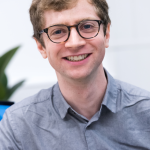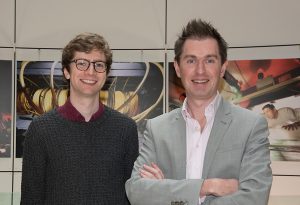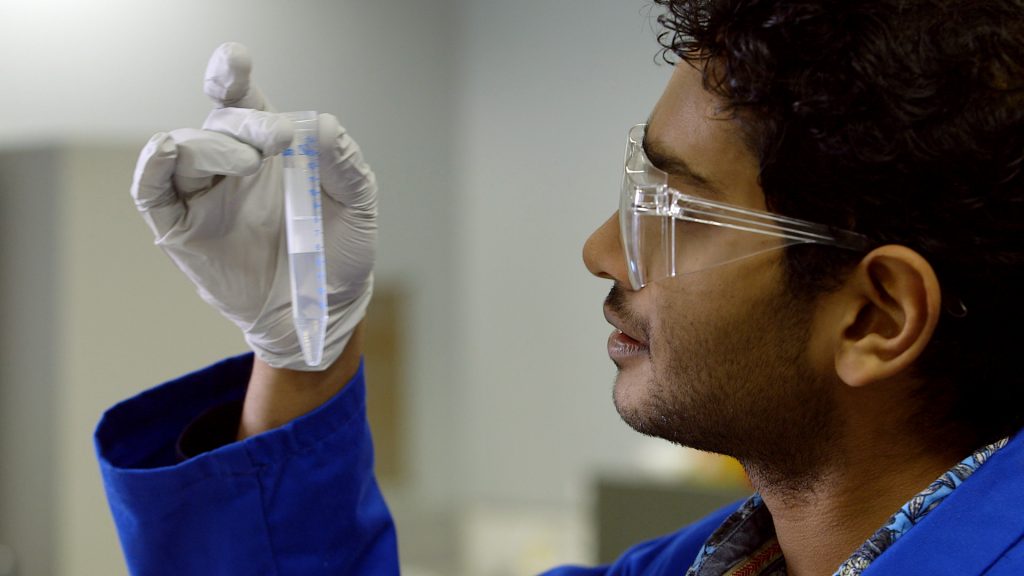 Dr Andrew Cairns is a Research Fellow in the Department of Materials. He is also a part of the LGBTQ+ community and Mental Health First Aider. To mark the end of Pride 2021, Dr Cairns shares more about his current research, his motivations for studying Materials Science and the importance of having an LGBTQ+ role model in STEM.
Dr Andrew Cairns is a Research Fellow in the Department of Materials. He is also a part of the LGBTQ+ community and Mental Health First Aider. To mark the end of Pride 2021, Dr Cairns shares more about his current research, his motivations for studying Materials Science and the importance of having an LGBTQ+ role model in STEM.
Hi, I’m Andrew, and I’m a Research Fellow in the Department of Materials. To give you an overview of my research: I investigate materials that behave in the opposite way than you might expect: so, instead of expanding when heated, they shrink. Even more bizarrely, under pressure, they expand rather than compressing in every direction.
We have found examples of these behaviours that are very extreme in a class of materials called molecular frameworks. We continue to look for larger and even more unusual properties and link properties together to engineer multi-functional materials. The challenge that drives me is how to manipulate matter — atom by atom — to realise advanced functionality.
Motivating this work further is the impact such unusual materials could have on future technologies. These properties — today mostly seen as curiosities — could enable more sensitive touch screens, devices with variable-pressure recognition, more accurate sensors, or more efficient data storage. We aim for a step-change in device performance that will only be possible with radically different materials than those currently used. So, alongside making new materials, we are working to fabricate these materials into prototype forms (like very thin coatings) that could be integrated into devices.
‘Science is AMAZING’
Like most of us in science, there is huge joy when you discover something no one else has ever seen before. During my doctoral studies, I remember the first time this happened: my supervisor and I were staring at an Excel workbook, systematically inputting numbers as the machine outputted data, and not believing our eyes. We worked in almost silence until we went to lunch and could say, ‘is it true?… This is amazing!’ Who knew an Excel file would ever be that interesting?

Of course, not every day is eureka-central: it takes a lot of patience and many failed experiments to get to that point. In those times, the things I enjoy most are the people and amazing facilities I am very fortunate to work with. I worked previously at the European Synchrotron Radiation Facility (ESRF), one of the most intense sources of X-rays in the world. I was blown away by the dedication of the scientists there and the ingenuity of the engineers who keep such a massive machine working (it has a circumference of over 800 m). Today, I continue to work with groups close to home, such as the Henry Royce Institute and all around the world. Getting involved in projects and seeing ideas develop with others is rewarding every day, including supporting students and colleagues to achieve great results.
The importance of LGBTQ+ role models in STEM
I was extremely fortunate that my doctoral supervisor, Prof Andrew Goodwin, is one of only a few LGBT+ academics in STEM. I was not aware of this when I first met him, but I am sure that having this role model has changed my experience in science. On one level, having someone to look up to gives confidence that my sexuality shouldn’t hold me back. This makes it easier each time I have to come out in a professional context. On another, I know that if ever I did experience hostility (I am fortunate this has never happened), I have a large group of supporters who would make it clear that such behaviour was not acceptable. There is huge power in knowing you are not alone.
Bringing your whole self to work is something I feel is so important in a job like being an academic for LGBT+ scientists or any other underrepresented group. We are often working 1:1 with collaborators, students and colleagues to support one another where trust and openness are key. Having been supported in my own journey makes me absolutely committed to doing my best for those around me.
I am therefore passionate about doing great science but working to make academia more welcoming and diverse. To me, these are one in the same: if we treated our equipment badly, we would expect bad data and therefore bad science, so why expect anything different from our people? More broadly, why does academia shelter, and in some cases celebrate, harassers and bullies? All our efforts in equality, diversity, and inclusion should be celebrated as a central part of being a scientist. And I continue to learn: to do my best science and to be the best scientist I can be. I am sure I will make mistakes in both areas, but I never want to lose the desire to do the right thing.

My advice for the next generation of LGBTQ+ Scientists and Engineers
Find your champion! I was lucky this was someone who I was interacting with every day, but there are more and more visible LGBT+ scientists and engineers out there who want to support the next generation. It might be that you are comfortable to come out and share your experiences with these people, to find that community, and that is great. Or it might be that you are less comfortable, and so even just checking the Twitter account of an LGBT+ scientist or engineer you admire can help give you a sense of connection.
We also must recognise how different parts of our community have different challenges, and others may live in countries where it is simply not possible to be out. Everyone has a responsibility to respect difference, acknowledge privilege and educate ourselves. In particular, current attacks on the trans* community are deeply worrying, reminding us all that rights that may seem to be won can be taken away just as easily. If you can, fly the flag and celebrate – but remember Pride is still a protest, and there is work to be done.

